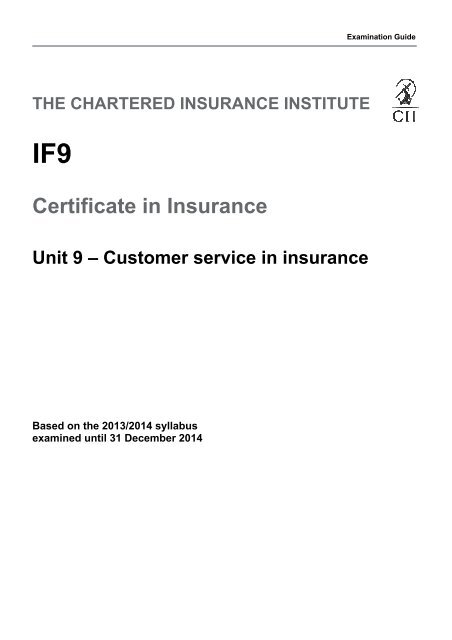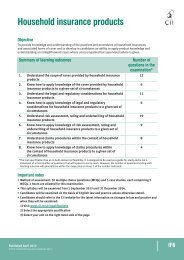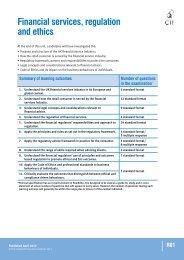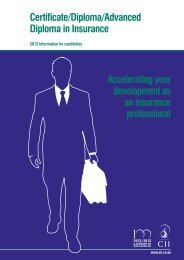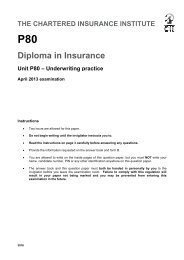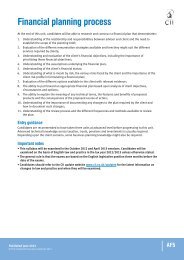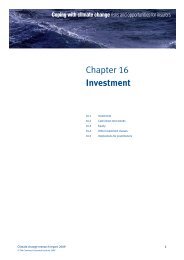exams sat between 1 September 2013 - 31 December 2014
exams sat between 1 September 2013 - 31 December 2014
exams sat between 1 September 2013 - 31 December 2014
Create successful ePaper yourself
Turn your PDF publications into a flip-book with our unique Google optimized e-Paper software.
Examination GuideTHE CHARTERED INSURANCE INSTITUTEIF9Certificate in InsuranceUnit 9 – Customer service in insuranceBased on the <strong>2013</strong>/<strong>2014</strong> syllabusexamined until <strong>31</strong> <strong>December</strong> <strong>2014</strong>
Examination GuideUnit 9 – Customer service in insuranceBased on the <strong>2013</strong>/<strong>2014</strong> syllabus examined until <strong>31</strong> <strong>December</strong> <strong>2014</strong>ContentsIntroduction to Examination Guide 3IF9 Syllabus 6Specimen Examination 10Specimen Examination Answers and Learning Outcomes Covered 20Published in June <strong>2013</strong> by:The Chartered Insurance Institute42-48 High Road, South Woodford, London E18 2JPTelephone: 020 8989 8464Fax: 020 8530 3052Email: customer.serv@cii.co.uk© The Chartered Insurance Institute <strong>2013</strong>IF9 Examination Guide <strong>2013</strong>/<strong>2014</strong> 2
Examination GuideUnit 9 – Customer service in insuranceBased on the <strong>2013</strong>/<strong>2014</strong> syllabus examined until <strong>31</strong> <strong>December</strong> <strong>2014</strong>IntroductionThis examination guide has been produced by the Examinations Department at the Chartered Insurance Instituteto assist students in their preparation for the IF9 examination. It contains a specimen examination with answerkey.Ideally, students should have completed the majority of their studies before attempting the specimen examination.Students should allow themselves 90 minutes to complete the examination. They should then review theirperformance to identify areas of weakness on which to concentrate the remainder of their study time.Although the specimen examination in this guide is typical of an IF9 examination, it should be noted that it is notpossible to test every single aspect of the syllabus in any one particular examination. To prepare properly for theexamination, candidates should make full use of the tuition options available and read as widely as possible toensure that the whole syllabus has been covered. They should also endeavour to keep as up-to-date as possiblewith developments in the industry by reading the periodicals listed in the IF9 reading list, which is located on thesyllabus in this examination guide and on the CII website at www.cii.co.uk.Background InformationCII examination questions undergo a rigorous writing and editing process before reaching an examination. Thequestions are written to strict guidelines by practitioners with relevant technical knowledge and experience.Questions are very carefully worded to ensure that all the information required to answer the question is providedin a clear and concise manner. They are then edited by an independent panel of experienced practitioners whohave been specifically trained to ensure that questions are technically correct, clear and unambiguous. As a finalcheck, each examination is scrutinised by the Senior Examiner and a CII assessment expert.Occasionally a question will require amendment after the examination guide is first published. In such an event,the revised question will be published on the CII website:1) Visit www.cii.co.uk/qualifications2) Select the appropriate qualification3) Select your unit on the right hand side of the pageCandidates should also refer here for the latest information on changes to law and practice and when they will beexamined.SyllabusThe IF9 syllabus is published on the CII website at www.cii.co.uk. Candidates should note that theexamination is based on the syllabus, rather than on any particular tuition material. Of course, the tuitionmaterial will provide the vast majority of the information required to perform well in the examination, but the CIIrecommends that students consult other reference materials to supplement their studies.IF9 Examination Guide <strong>2013</strong>/<strong>2014</strong> 3
Examination GuideSkill SpecificationThe skill level tested in each examination question is determined by the syllabus. Each learning outcome specifiesthe level of skill required of candidates and thus the level at which candidates may be tested. Learning outcomesfor IF9 begin with know or understand. Different skill levels lead to different types of question, examples of whichfollow.KnowUnderstandKnowledge-based questions require the candidate to recall factual information. Typicallyquestions may ask ‘What’, ‘When’ or ‘Who’. Questions set on a know learning outcomecan only test knowledge.To answer questions based on understanding, the candidate must be able to link piecesof information together in cause-and-effect relationships. Typically questions may ask‘Why’. Questions set on an understand learning outcome can test either knowledge orunderstanding or both.Examination InformationThe method of assessment for the IF9 examination is 50 multiple choice questions (MCQs) written to 10 casestudies. 90 minutes is allowed for this examination.The IF9 syllabus provided in this examination guide will be examined from 1 <strong>September</strong> <strong>2013</strong> until<strong>31</strong> <strong>December</strong> <strong>2014</strong>.Candidates will be examined on the basis of English law and practice unless otherwise stated.The general rule is that legislative and industry changes will not be examined earlier than 3 months after theycome into effect.A multiple choice question consists of a problem followed by four options, labelled A, B, C and D, from which thecandidate is asked to choose the correct response. Each question will contain only one correct or best responseto the problem posed. One mark is awarded for each correct response identified by the candidate. No mark isawarded if the candidate either chooses an incorrect response, chooses more than one response or fails tochoose any response. No marks are deducted for candidates choosing an incorrect response.While no questions involve complex calculations, candidates are permitted to use calculators during theexamination. If you bring a calculator into the examination room, it must be a silent battery orsolar-powered non-programmable calculator. The use of electronic equipment capable of being programmed tohold alphabetic or numerical data and/or formulae is prohibited. You may use a financial or scientific calculator,provided it meets these requirements.Candidates are permitted to make rough notes. Candidates are not permitted, under any circumstances, toremove any papers relating to the examination from the examination room.IF9 Examination Guide <strong>2013</strong>/<strong>2014</strong> 4
Examination GuideExamination Technique: Multiple Choice QuestionsThe best approach to multiple choice examinations is to work methodically through the questions.The questions are worded very carefully to ensure that all the information required is presented in a concise andclear manner. It cannot be emphasised too strongly that understanding the precise meaning of the question isvital. If candidates miss a crucial point when reading the question it could result in choosing the wrong option.Candidates should read carefully through the question and all the options before attempting to answer.Candidates should pay particular attention to any words in the question which are emphasised in bold type, forexample, maximum, minimum, main, most, normally and usually. Negative wording is further emphasised bythe use of capital letters, for example NOT, CANNOT.Candidates should not spend too much time on any one question. If they cannot make up their mind, they shouldleave the question and come back to it later.When all of the questions have been answered, it is prudent to use any remaining time to go through eachquestion again, carefully, to double-check that nothing has been missed. Altering just one incorrect response to acorrect response could make the difference <strong>between</strong> passing and failing.After the ExaminationRigorous checks are made to ensure the correctness of the results issued. A pre-defined quota of passes to beawarded does not exist. If all candidates achieve a score of at least the pass mark, then all candidates will beawarded a pass grade. Individual feedback on the candidate’s examination performance is automatically providedand will indicate the result achieved and, for each syllabus learning outcome, the percentage of questions in theexamination that were answered correctly.IF9 Examination Guide <strong>2013</strong>/<strong>2014</strong> 5
Customer service in insuranceObjectiveTo provide knowledge and understanding of the customer service within the context of an insuranceenvironment.Summary of learning outcomesNumber ofquestions in theexamination*1. Know how to fulfil customer requirements in the insurance sector 92. Understanding the importance of customer feedback to improve service in4the insurance sector3. Understand the importance of good communication to maintain and build7client relationships in the insurance industry4. Know how to deal with conflict within an insurance environment 45. Understand the importance of keeping accurate and confidential records3when dealing with customers6. Know how to manage own workload and time to meet business2requirements and timescales7. Know how to work with others to achieve team and organi<strong>sat</strong>ional7objectives8. Understand the sales process 79. Know how to increase sales activities 410. Know the main regulatory and legal requirements applicable to the3application of insurance business*The test specification has an in-built element of flexibility. It is designed to be used as a guide for study and is not astatement of actual number of questions that will appear in every exam. However, the number of questions testing eachlearning outcome will generally be within the range plus or minus 2 of the number indicated.Important notes• Method of assessment: 50 multiple choice questions (MCQs) written to 10 case studies. 90 minutes isallowed for this examination.• This syllabus will be examined from 1 <strong>September</strong> <strong>2013</strong> until <strong>31</strong> <strong>December</strong> <strong>2014</strong>.• Candidates will be examined on the basis of English law and practice unless otherwise stated.• Candidates should refer to the CII website for the latest information on changes to law and practice andwhen they will be examined:1) Visit www.cii.co.uk/qualifications2) Select the appropriate qualification3) Select your unit on the right hand side of the pagePublished April <strong>2013</strong>© The Chartered Insurance Institute <strong>2013</strong>IF9
1. Know how to fulfil customerrequirements in the insurance sector1.1 Outline the structure and operation of theinsurance market1.2 Describe the features of utmost good faith1.3 Describe the methods used to obtain material facts1.4 Explain the various types of customer in theinsurance sector including their needs anddemands1.5 Explain the importance of customers’ experiencesin developing good relationships1.6 Explain the link <strong>between</strong> customers’ previousexperiences and their future likely buyingintentions1.7 Explain why it is important to observe legal,organi<strong>sat</strong>ional and ethical rules when providinginformation to customers1.8 Explain why it is important to give customerscurrent and accurate information1.9 Explain the possible consequences of not givingcustomers current and accurate information1.10 Explain the importance of effective complaintshandling1.11 Explain the factors affecting the attraction andretention of customers1.12 Explain ways in which relationships withcustomers can be improved1.13 Describe the issues and concerns which may affectboth internal and external customers1.14 Explain the importance of keeping customersupdated on progress2. Understanding the importance ofcustomer feedback to improve servicein the insurance sector2.1 Explain the importance of customer feedback2.2 Describe different methods of collecting formal andinformal feedback2.3 Explain various ways that feedback can be depicted(charts, graphs, pictograms)2.4 Describe Data Protection legislation and itsimplications for collecting, storing and usingcustomer feedback3. Understand the importance of goodcommunication to maintain and buildclient relationships in the insuranceindustry3.1 Explain the stages in the communication process3.2 Describe barriers to communication and how thesecan be overcome3.3 Explain the advantages and disadvantages of thevarious methods of communication3.4 Explain how non-verbal communication caninfluence relationships in the insurance industry3.5 Explain why it is important to use feedback tocheck the effectiveness of the information beingconveyed3.6 Explain the importance of accurate and clearwritten communication3.7 Describe the steps of the ideal call structure andthe skills needed at each stage3.8 List common forms of challenging calls anddescribe ways to deal with them4. Know how to deal with conflict withinan insurance environment4.1 Describe factors that can trigger an angry responsein customers4.2 Explain the stages in the escalation of conflict4.3 Explain the importance of following organi<strong>sat</strong>ionalpolicies and guidelines when dealing with conflictsituations4.4 Describe ways in which conflict can be diffused5. Understand the importance of keepingaccurate and confidential records whendealing with customers5.1 Explain the importance of keeping accurate recordsof communication with customers5.2 Explain the importance of keeping customers’information confidential5.3 Explain the possible consequences of notmaintaining client confidentiality6. Know how to manage own workloadand time to meet businessrequirements and timescales6.1 Describe factors that may impact on personalworkload and time availability6.2 Explain techniques for managing workload andtime more effectively7. Know how to work with others toachieve team and organi<strong>sat</strong>ionalobjectives7.1 Explain what makes teams effective7.2 Explain how relevant information can be shared toenhance team effectiveness and lead to a positivecustomer experience7.3 Explain how individual behaviour can have apositive or negative effect on the team and howthis may impact the customer7.4 Explain how individuals can contribute towards theachievement of team and organi<strong>sat</strong>ional goals7.5 Explain how improved interpersonal skills canimprove the effectiveness of the team and providea positive customer experiencePublished April <strong>2013</strong> 2 of 4© The Chartered Insurance Institute <strong>2013</strong>
7.6 Explain what situations should be referred tosomeone with higher authority8. Understand the sales process8.1 Explain the difference <strong>between</strong> processing ordersand selling8.2 Describe the stages that lead to a sale8.3 Explain the difference <strong>between</strong> advised and nonadvisedsales8.4 Describe the key characteristics in successful faceto-faceand telephone selling8.5 Explain how telephone selling differs from otherselling methods8.6 Explain the preparation and structure of atelephone selling call9. Know how to increase sales activities9.1 Explain how to obtain sufficient information fromcustomers to support sales9.2 Describe how to make links <strong>between</strong> informationprovided by customers and products to create salesopportunities9.3 Describe how to communicate the features andbenefits of products to customers9.4 Explain how to identify cross-selling and upsellingopportunities9.5 Explain how to develop customer loyalty andretention10. Know the main regulatory and legalrequirements applicable to theapplication of insurance business10.1 Explain the role of the Financial Conduct Authority(FCA) and Prudential Regulation Authority (PRA)in the authori<strong>sat</strong>ion, supervision and regulation ofinsurers10.2 Explain the principles of Treating Customers Fairly(TCF)10.3 Describe the FCA’s requirements in relation tohandling complaints10.4 Describe the services provided by the FinancialOmbudsman ServiceReading listThe following list provides details of various publicationswhich may assist with your studies. Periodicals andpublications will be of value in ensuring candidates keepup to date with developments and in providing a widercoverage of syllabus topics. Any reference materials citedare authoritative, detailed works which should be usedselectively as and when required.Note: The examination will test the syllabus alone.The reading list is provided for guidance only and is notin itself the subject of the examination.CII/Personal Finance Society members can borrow mostof the additional study materials below from KnowledgeServices. CII study texts can be consulted from within thelibrary. For further information on the lending service,please go to www.cii.co.uk/knowledge.CII study textsCustomer service in insurance. London: CII. Study text IF9.Additional readingFactfiles and other online resourcesThe regulation of general insurance and protectionbusiness. Tony Wiltshire, rewritten and updated by IanYoungman. London: CII Knowledge Services. Updated asnecessary. Available online (CII/Personal Finance Societymembers only) via www.cii.co.uk/knowledge.The Financial Ombudsman Service and general insurance.Peter Tyldesley, Saira Paruk. London: CII KnowledgeServices. Updated as necessary. Available online viawww.cii.co.uk/knowledge (CII/Personal Finance Societymembers only).Efficiency tactics within the insurance industry(forthcoming May <strong>2013</strong>). Ian Searle. London: CII KnowledgeServices. Updated as necessary. Available online viawww.cii.co.uk/knowledge (CII/Personal Finance Societymembers only).A useful guide to sales. Pansophix. Available online viawww.cii.co.uk/knowledge (CII/Personal Finance Societymembers only).A useful guide to customer services. Pansophix. Availableonline via www.cii.co.uk/knowledge (CII/Personal FinanceSociety members only).Reference materialsDictionary of insurance. C Bennett. 2nd ed. London:Pearson Education, 2004. Also available online(CII/Personal Finance Society members only) viawww.cii.co.uk/knowledge/resources.Published April <strong>2013</strong> 3 of 4© The Chartered Insurance Institute <strong>2013</strong>
PeriodicalsThe Journal. London: CII. Six issues a year. Also availableonline (CII/Personal Finance Society members only) viawww.cii.co.uk/knowledge.Post Magazine. London: Incisive Financial Publishing.Weekly.Examination guideAn examination guide, which includes a specimen paper, isavailable to purchase via www.cii.co.uk.If you have a current study text enrolment the specimenpaper is included, as a mock test, via Revisionmate(www.revisionmate.com). Details on how to access thisresource are on the first page of the study text.Exam technique/study skillsThere are many modestly priced guides available inbookshops. You should choose one which suits yourrequirements.The Insurance Institute of London holds a lecture onrevision techniques for CII <strong>exams</strong> approximately threetimes a year. The slides from their most recent lecturescan be found at www.cii.co.uk/knowledge/iilrevision(CII/Personal Finance Society members only).Published April <strong>2013</strong> 4 of 4© The Chartered Insurance Institute <strong>2013</strong>
Examination GuideGeorge is an insurance broker. As such he has an obligation to disclose which markets he uses in certaincircumstances.Six months ago George arranged car insurance for Kevin, who recently submitted a claim.The insurer has been obliged to settle the claim but is now exercising its right of recovery against Kevin.George is disappointed at these events as he had highlighted the significance of the proposal formdeclaration to Kevin.The insurer with which George has placed Kevin’s business is a branded company within a largerorgani<strong>sat</strong>ion. The organi<strong>sat</strong>ion operates an internal benchmarking policy.The main organi<strong>sat</strong>ion makes significant use of internal quality systems.George has demonstrated his level of competence and is fulfilling his ongoing competency requirements.1. In what circumstances must George always disclose which markets he uses?A. When he charges a fee for his services.B. When he issues documents on behalf of insurers.C. When he settles claims on behalf of insurers.D. When requested to do so by the insured.2. The insurer’s action to recover its outlay from Kevin indicates that he most likely hasA. failed to disclose a material fact in answer to a question.B. failed to pay more than one monthly premium.C. innocently stated a fact incorrectly.D. a spent criminal conviction.3. The significance of the declaration on the proposal form which George pointed out to Kevin is thatA. the contract remains in force following a claim.B. George is indemnified against any adverse consequence of the advice given.C. the information given forms the basis of the contract.D. Kevin has received and approved the policy terms and exclusions.4. The benchmarking policy used by Kevin’s insurer means thatA. analysis can be made as to what is contributing to the success of the company.B. external factors can easily distort the results.C. it is impossible to achieve a detailed understanding of internal processes and systems.D. service standards across the industry are compared.5. The internal quality systems used by the main organi<strong>sat</strong>ion are most likely to be based onA. analysis of the feedback given on social media.B. feedback from customer service operatives.C. reviewing of customer files.D. specialist tools used to trawl websites.6. With regard to his competency requirements, George must nowA. achieve and record a <strong>sat</strong>isfactory continuous standard.B. become an approved person.C. complete his period of supervision.D. sit and pass specified approved qualifications.IF9 Examination Guide <strong>2013</strong>/<strong>2014</strong> 10
Examination GuideColin works in the customer service department of an insurer and is a member of the Chartered InsuranceInstitute (CII). He is investigating a query from Rachel regarding the delay in her receiving amended policydocumentation.Colin discovers that an error made by a colleague has meant that the amendment has NOT yet been made.Colin is tempted to tell Rachel that a computer system error has occurred, rather than implicate his colleague.Colin asks another colleague, Amy, what he should do.Rachel is the type of person who only makes official complaints which she considers fully appropriate.However, she regularly comments about her experiences online.Following their initial conver<strong>sat</strong>ion, Rachel completed an interactive voice system survey regarding the levelof service received and level of <strong>sat</strong>isfaction with the product.Colin has been reading about the Financial Conduct Authority’s Enhanced Capital Requirement (ECR) but isnot sure he understands its significance.7. The explanation Colin wants to give to Rachel regarding her amended policy documentsA. breaches the CII Code of Ethics.B. breaches the Financial Ombudsman Service’s regulations.C. is acceptable provided no financial loss has occurred.D. is acceptable provided the error is rectified immediately.8. Amy should advise Colin toA. insist the colleague who was initially responsible responds to Rachel.B. maintain his suggested approach as this will meet Rachel’s expectations.C. provide the correct explanation in the interests of ongoing trust and confidence.D. report the matter to the regulator immediately.9. If Rachel discovers the source of the error regarding her documents, she is most likely toA. immediately cancel her policy.B. lodge an official complaint with the regulator.C. only inform family and close friends.D. post details on social media sites.10. The survey which Rachel has completedA. allows her to record full comments about her experience.B. cannot cater for a customer’s specific views or feelings.C. can only provide feedback to the insurer at one level.D. only allowed her to rate her experiences on a 1 to 5 scale.11. The significance of the ECR is thatA. an insurer with a higher than average solvency ratio must set aside increased amounts to smooth futurefluctuations.B. an insurer with a low solvency ratio must find a guarantor to cover fluctuating claims levels.C. minimum funds must be available at all times to cover the cost of present and future claims.D. minimum funds must be available on an ongoing basis to cover trading costs for at least 10 years.IF9 Examination Guide <strong>2013</strong>/<strong>2014</strong> 11
Examination GuideHarry has the status of an Approved Person. He manages the marketing department of an insurer andrecognises the effect the recession has on their customers. He is focusing his current marketing planaccordingly.Harry’s organi<strong>sat</strong>ion has developed a strong customer relationship management policy and holds significantdata on customer buying habits and identified needs including customer feedback. The organi<strong>sat</strong>ion is veryconscious of being seen to be cost-efficient in its efforts to engage with customers and promote newbusiness.Harry’s organi<strong>sat</strong>ion is introducing service level agreements <strong>between</strong> internal departments. This requiresHarry to consider how he and his team should react to requests from colleagues.12. Harry’s current marketing plan should focus onA. features and benefits which are essential at all times.B. highlighting the simplicity of purchasing online.C. opening up new markets to attract customers with high disposable incomes.D. the flexibility available from additional product options.13. Harry can best make use of his company’s database byA. increasing the number of direct mailshots advising of all new products introduced.B. informing customers only about new products and services which match their profiles.C. sending regular emailed newsletters informing customers about service level improvements.D. telephoning customers to offer to review their insurance portfolio and upgrade cover levels.14. The implication of the service level agreements from Harry’s point of view are that he mustA. be able to demonstrate how colleagues’ needs are being met.B. justify to other departments any changes to published marketing plans.C. offer to accommodate team members in the timescales they request.D. react more quickly to requests from external customers.15. The most likely method that Harry’s organi<strong>sat</strong>ion would use to obtain customer feedback would beA. electronic post-contact surveys.B. focus groups.C. paper-based questionnaires.D. web-watching.16. Harry’s status indicates that he hasA. demonstrated his honesty and integrity.B. no outstanding debts or liabilities.C. passed a series of approved qualifications.D. <strong>sat</strong>isfied the extra requirements of the Training and Competence Sourcebook.IF9 Examination Guide <strong>2013</strong>/<strong>2014</strong> 12
Examination GuideChloe is a new junior member of an insurer’s customer service team. Her line manager, Jack, notices thatshe is struggling to give a clear, structured message when speaking to customers on the telephone. Jack iskeen to see Chloe’s skills improve as she demonstrates a good level of empathy with customers who haveproblems.Chloe has a strong local accent which can be difficult to understand. The colleagues she most commonlyhas to consult in her case investigations are based in the same office. All telephone conver<strong>sat</strong>ions withcustomers are recorded.Jack coaches Chloe and is pleased to notice a significant improvement in her signposting skills. He alsotakes the opportunity to reinforce the need to make accurate file notes to back up the recordings ofconver<strong>sat</strong>ions with customers.17. In order to help Chloe provide clearer messaging, Jack should suggest that sheA. avoids using potentially emotive words.B. improves her body language.C. inflects a greater variety in her tone of voice.D. prepares a list of the key points she needs to cover.18. It is important that Chloe improves her ability to make file notes as she will definitely be required toA. make comprehensive reports to the regulator regarding actions taken.B. obtain commitment from her colleagues regarding changes in processes.C. participate in conference calls with members of other teams.D. process cases involving detailed, technical issues.19. Chloe’s ability to empathise is particularly useful in order toA. ensure customers are receiving the correct level of service.B. explain the next steps in the investigation process.C. give confidence to customers that they are valued.D. question whether or not the customer has understood her message.20. Chloe’s improvement in signposting means that she is better atA. answering customer questions in a clear and concise manner.B. keeping the customer informed as to the progress of their call.C. summarising in order to close the conver<strong>sat</strong>ion.D. using probing questions to obtain more in-depth information.21. The primary importance of the accuracy of the notes Chloe is required to make is toA. enable the regulator to make a judgement.B. make her fully accountable for her actions.C. provide a complete audit trail.D. <strong>sat</strong>isfy Data Protection requirements.IF9 Examination Guide <strong>2013</strong>/<strong>2014</strong> 13
Examination GuideSusie is an insurance customer service manager who has received several complaints from her teamregarding Keith, whose body language is causing problems. A team member, Julie, has complained severaltimes that she finds Keith intimidating.Susie’s team regularly writes to customers. One customer has complained to Julie that her letter wasaddressed to her late husband, despite the fact that she had previously notified them of his death. Julie isadamant that she has followed the correct procedure.Julie has a challenging call from this customer, who is clearly angry and offended at the way the letter wasaddressed.She also says that she did NOT give Julie’s organi<strong>sat</strong>ion permission to hold her personal data. Julieresponds appropriately, however, the customer remains angry and threatens to take legal action under theData Protection Act 1998.Susie feels that this is an idle threat, but is concerned about the potential indirect costs.22. The problem Julie has with Keith’s behaviour is most likely to be that heA. constantly frowns when listening to her.B. refuses to make eye contact.C. shuffles from one leg to the other.D. stands very close when talking to her.23. The reason for the customer’s complaint about the letter is most likely to be thatA. the records of her deceased husband have not been updated.B. she has been a client for many years.C. she sees this as a breach of her Data Protection rights.D. she sees this as a regulatory breach.24. Upon receiving the challenging call, Julie should initiallyA. allow the customer to express her concerns.B. explain to the customer the procedure which has been followed.C. promise the customer that her records will be amended accordingly.D. state her organi<strong>sat</strong>ion’s policy to treat customers fairly.25. Julie’s response regarding the customer’s personal data will explain that itA. is for the protection of the customer’s best interests.B. is necessary to hold it to fulfil the contract.C. may be necessary in the future to use it for the administration of justice.D. will be removed from the database on receipt of her formal request.26. The potential indirect costs which concern Susie are most likely to be theA. drop in retention rates.B. fines imposed by the regulator.C. legal expenses for disciplinary action.D. time and investigation charges.IF9 Examination Guide <strong>2013</strong>/<strong>2014</strong> 14
Examination GuideTed is an insurance claims team manager. His team is under additional pressure because an IT systemupgrade is failing to perform effectively, which has resulted in having to return claimants’ calls to complete theclaim registration process. Ted is concerned about how claimants may react, although he is confident thathis team can handle the situation well.Ted has been identified as a coordinator according to Belbin’s team roles and exhibits the typical traits of thisrole. Ted is also excellent at sharing information with his team.Ted is currently involved in tactical planning towards the achievement of his organi<strong>sat</strong>ion’s corporateobjectives. To achieve these objectives, Ted must ensure that he exercises his assertiveness skills tomaximum effect.27. Ted’s concern regarding claimants is most likely to be that they willA. complain to the regulator.B. demand compen<strong>sat</strong>ion.C. perceive the company to be inefficient.D. submit exaggerated claims.28. According to Belbin’s team roles, Ted would be seen asA. analytical.B. extrovert.C. self-confident.D. trustful.29. What effect will Ted’s attitude towards sharing information have on his team?A. High dependency.B. Low morale.C. Performance enhancement.D. Resentment.30. Ted’s particular responsibilities towards the achievement of the corporate objectives are most likely torequire him toA. plan a general overview of his team’s performance requirements.B. plan overall objectives covering his department for the next five years.C. set daily tasks for his team members.D. submit weekly performance targets for the next few months.<strong>31</strong>. In exercising his assertiveness skills, Ted will demonstrateA. the ability to develop common interests with his colleagues.B. consideration for the rights and needs of his team.C. a deeper understanding of his colleagues’ perspectives.D. how to reduce stress levels in the working environment.IF9 Examination Guide <strong>2013</strong>/<strong>2014</strong> 15
Examination GuideAdam is a team manager in an insurance company’s contact centre. He has asked his team to completedaily time logs in order to assess how to improve management of an increasing workload. Of particularconcern is the time spent generally chatting and fetching tea and coffee.Of secondary concern is the amount of time taken to read the weekly technical update reports, which tend tobe issued without any team briefing. The reports are lengthy but certain aspects are highly relevant to theteam. They are prepared and issued by another department.Performance appraisals are imminent and Adam also has to examine the merit ratings of his team membersto determine their salary increases. Whilst conducting Mandy’s appraisal, Adam finds that Mandy stronglydisagrees with him regarding certain aspects of her performance and she is angry at the possibility that thismight adversely affect her salary increase. She refuses to sign the appraisal form unless Adam amends itscontents.32. The issue of time-wasting should primarily be addressed byA. allocating times for refreshments.B. more effective prioriti<strong>sat</strong>ion of tasks.C. the relocation of equipment.D. a request for increased self-discipline.33. In order to address the issue regarding the reports, Adam shouldA. hold weekly team briefings to outline the key points.B. issue explanatory notes to supplement the report.C. issue only the sections needed immediately.D. prepare the main report in bullet-point format.34. With regard to the issue of salary increases, Adam will be required toA. assess each team member against a set of defined criteria.B. discuss with each team member how their development needs should relate to their salary.C. explain to his team how the profit-sharing percentage available has been calculated.D. include this as part of the performance review.35. In the circumstances of Mandy’s appraisal, Adam’s best course of action is most likely to be toA. agree with Mandy an appropriate compromise.B. conduct a reassessment of team management.C. discipline Mandy and process the form as it stands.D. discuss the situation with his line manager before agreeing the next steps.IF9 Examination Guide <strong>2013</strong>/<strong>2014</strong> 16
Examination GuideJanice telephones Damian in the customer service team of her insurer to try to add her son to her motorpolicy. Damian is a new team member and is having problems with the computer system, which today is veryslow.Janice is getting very annoyed as she is in a hurry. She accuses Damian of NOT listening to her. Damiantries to explain the situation and asks her to please be patient with him.Janice complains that she has NOT got time to be patient and insists on being referred to Damian’s linemanager, Sarah. Sarah is being particularly vigilant regarding the progress of calls as she is aware of thecomputer system issue. Two other team members are also having difficult calls so Sarah tries to balance hertime <strong>between</strong> them. Sarah reminds the team to follow the guidelines for handling conflict with customers.36. Janice’s annoyance can be attributed toA. feeling that she is being held responsible for the situation.B. feeling that she is not being treated as a valued customer.C. a perceived lack of product knowledge.D. a significant clash of interpersonal styles.37. At the point where Janice asks to be referred to Sarah, Damian should initiallyA. be honest about the situation and attempt to regain Janice’s trust.B. follow the team’s complaints guidelines.C. insist that Sarah takes over the call.D. tell Janice that Sarah will not be able to do any more than he can.38. The guidelines to which Sarah refers are primarily there toA. ensure customers are treated fairly.B. maintain productivity and reduce reputational damage.C. make team members feel more secure.D. <strong>sat</strong>isfy health and safety regulations.39. How should Damian initially attempt to diffuse the situation with Janice?A. Acknowledge her anger and allow her to express her emotion.B. Interrupt her to explain the company’s position.C. Offer her a premium discount.D. Provide her with details of the Financial Ombudsman Service.IF9 Examination Guide <strong>2013</strong>/<strong>2014</strong> 17
Examination GuideTim works for an insurer and he has received an urgent lead regarding a potential new complex commercialclient. At this stage he knows very little about the client and is going through the necessary pre-call activity.His client contact is Danny, a director of the firm. Tim knows that, in order to complete the sale of any policy,he will need to visit Danny’s company.When Tim speaks to Danny, he finds that Danny tends to give short and abrupt answers to his questions.Tim needs more in-depth knowledge in order to give appropriate advice.Tim discovers that Danny is <strong>sat</strong>isfied with the level of cover and policy features provided by his currentinsurer, but feels the renewal quotation they have provided is far too expensive. Danny also felt that oncethey had obtained his business, the current insurer showed little further interest. Tim puts forward asuggestion to improve this situation.40. The most important detail that Tim should have obtained about the company before telephoning Dannywould have been theA. name of Danny’s current insurer.B. name of Danny’s line manager.C. nature of Danny’s business.D. type of exclusions likely to apply.41. When Tim telephoned Danny, he should initially have made it clear that the purpose of the call was toA. analyse the needs of Danny’s company.B. arrange a face-to-face appointment.C. get the policy on risk.D. give details of the quotation.42. The type of questions Tim should use to obtain the information he needs from Danny are most likely to beA. closed.B. probing.C. reflective.D. rhetorical.43. In order to obtain the business from Danny, Tim’s primary aim must be to demonstrate that he canA. offer more flexible policy options.B. reduce Danny’s stress when claims arise.C. reduce the number of exclusions applicable.D. save Danny’s company money.44. What should Tim suggest to address Danny’s perception of the lack of interest once the sale is closed?A. He includes Danny on his email update list.B. He personally oversees the handling of any claim.C. They complete a demands and needs statement.D. They hold regular review meetings.IF9 Examination Guide <strong>2013</strong>/<strong>2014</strong> 18
Examination GuideAmanda sells general insurance on an advised basis. She is meeting Greg to discuss his policies, which arecoming up for renewal in three weeks’ time. Amanda had called Greg three times before the appointmentwas made.In analysing Greg’s needs, Amanda finds that there are two possible solutions and it is difficult to differentiate<strong>between</strong> them.During the meeting, Greg mentions to Amanda that his brother is unhappy with his current insurer and hispolicies are due for renewal in the near future.At the conclusion of the meeting, when Greg has decided to proceed, he praises Amanda on the level ofpreparation he feels she must have made.Following the agreement to proceed, Amanda passes the files to Jane to process the paperwork.When Jane contacts Greg before processing the paperwork, he tells her that he is considering purchasing asmall flat for his son’s university accommodation.45. In discussing insurance policies with Greg, Amanda mustA. avoid making comparisons <strong>between</strong> competing products.B. ensure Greg understands that the final product choice must be his.C. explain why a particular provider’s product would meet Greg’s needs.D. focus primarily on generic products and features.46. When considering the difficulty Amanda has identified in presenting Greg with a solution, she should focus onA. selling the product which would be of most benefit to her firm.B. the soft facts which may indicate Greg’s more in-depth needs.C. which solution has the greater number of features.D. which solution has the lower premium cost.47. Greg’s praise of Amanda is most likely to be because sheA. demonstrated a high level of knowledge about product features and benefits.B. had persevered in contacting him to arrange their meeting.C. used open and probing questioning techniques.D. was very efficient in outlining the next steps to be taken.48. When compared to Amanda, Jane needs to demonstrateA. a higher level of attention to detail.B. a lower level of focus on ongoing account management.C. the same level of ongoing customer contact.D. at least the same level of service delivery.49. From the information Greg supplies to Amanda about his brother’s policies, she should recognise thatA. the best course of action is to ask Jane to investigate this further with Greg.B. the onus is on Greg to pass on Amanda’s contact details.C. she can now ask for a direct referral from Greg.D. she should just provide Greg with additional sales literature for him to pass on.50. When Jane speaks to Greg regarding the processing of the paperwork, she should recognise the informationhe supplies regarding a flat for his son primarily asA. evidence that she has good signposting skills.B. an ideal opportunity to refer him back to Amanda.C. important for the processing of Greg’s policies.D. an instant opportunity to increase his policy premium.IF9 Examination Guide <strong>2013</strong>/<strong>2014</strong> 19
Examination GuideSpecimen Examination Answers and Learning Outcomes CoveredQuestion AnswerLearningLearningQuestion AnswerOutcomeOutcome Question Answer LearningOutcome1 D 1.1 22 D 3.4 40 C 8.22 A 1.2 23 A 3.6 41 B 8.63 C 1.3 24 A 3.8 42 B 8.44 A 2.1 25 B 5.2 43 D 9.35 C 2.2 26 D 5.3 44 D 9.56 A 10.127 C 6.1 45 C 8.37 A 1.7 28 B 7.1 46 B 8.28 C 1.8 29 C 7.3 47 A 8.49 D 1.9 30 A 7.4 48 D 8.110 A 2.2 <strong>31</strong> B 7.5 49 C 9.211 C 10.1 50 B 9.432 D 6.212 A 1.11 33 A 7.213 B 1.12 34 A 7.414 A 1.12 35 D 7.615 A 2.216 A 10.1 36 B 4.137 A 4.217 D 3.2 38 A 4.<strong>31</strong>8 D 3.6 39 A 4.419 C 3.720 B 3.721 C 5.1IF9 Examination Guide <strong>2013</strong>/<strong>2014</strong> 20


